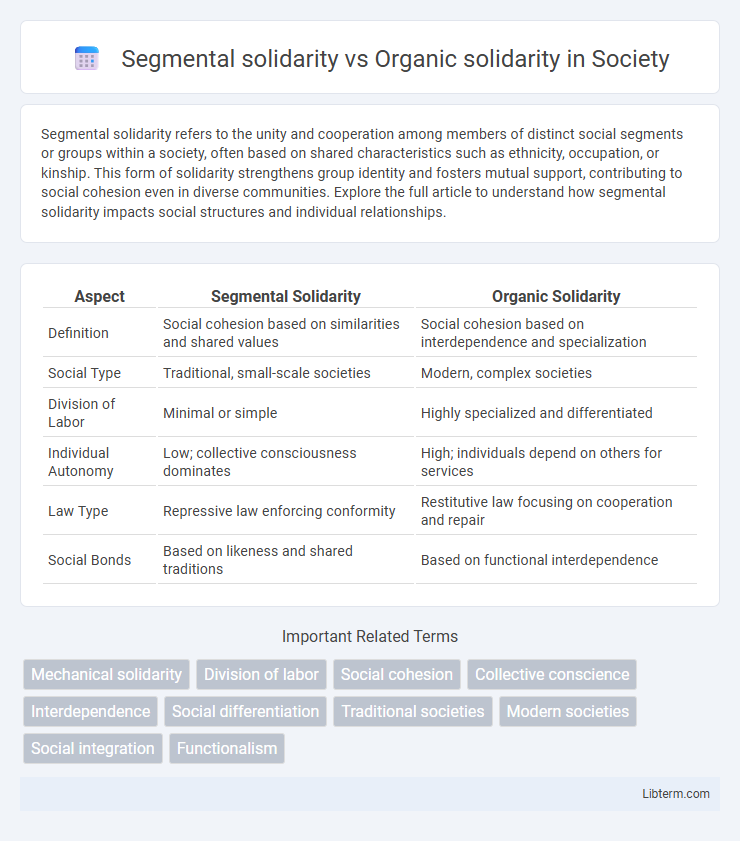Segmental solidarity refers to the unity and cooperation among members of distinct social segments or groups within a society, often based on shared characteristics such as ethnicity, occupation, or kinship. This form of solidarity strengthens group identity and fosters mutual support, contributing to social cohesion even in diverse communities. Explore the full article to understand how segmental solidarity impacts social structures and individual relationships.
Table of Comparison
| Aspect | Segmental Solidarity | Organic Solidarity |
|---|---|---|
| Definition | Social cohesion based on similarities and shared values | Social cohesion based on interdependence and specialization |
| Social Type | Traditional, small-scale societies | Modern, complex societies |
| Division of Labor | Minimal or simple | Highly specialized and differentiated |
| Individual Autonomy | Low; collective consciousness dominates | High; individuals depend on others for services |
| Law Type | Repressive law enforcing conformity | Restitutive law focusing on cooperation and repair |
| Social Bonds | Based on likeness and shared traditions | Based on functional interdependence |
Introduction to Social Solidarity
Segmental solidarity is characterized by social cohesion based on similarities and shared beliefs among individuals or small groups, typical in traditional societies with strong kinship bonds. Organic solidarity emerges in complex, modern societies where interdependence arises from the division of labor, meaning individuals rely on specialized roles and collective cooperation. Both forms illustrate Emile Durkheim's concept of social solidarity, explaining how societies maintain cohesion through either homogeneity or functional interdependence.
Defining Segmental Solidarity
Segmental solidarity refers to social cohesion based on the similarity and equality of individuals or groups within small, homogeneous communities, often found in tribal or kinship societies. It is characterized by a strong collective consciousness where shared beliefs and values create unity without a complex division of labor. Unlike organic solidarity, which arises in advanced societies through interdependence and specialization, segmental solidarity depends on the resemblance and autonomy of its members.
Defining Organic Solidarity
Organic solidarity defines social cohesion through the interdependence of individuals in a complex division of labor, where personal differences and specialized roles unite members of society. Unlike segmental solidarity, which relies on homogeneity and shared beliefs within small, similar groups, organic solidarity thrives in diversified societies with interconnected functions. This type of solidarity emphasizes social integration based on mutual reliance and cooperation across varied social roles.
Historical Context and Origins
Segmental solidarity originates from pre-industrial, tribal societies where social cohesion is maintained through kinship ties and shared cultural values, reflecting Emile Durkheim's analysis of early social structures. Organic solidarity emerges during industrialization, characterized by increased division of labor and interdependence among individuals with specialized roles, representing a shift towards complex, modern society. Durkheim's historical context links segmental solidarity to mechanical social integration in homogeneous groups, while organic solidarity corresponds to heterogeneity and functional differentiation in advanced economies.
Key Differences Between Segmental and Organic Solidarity
Segmental solidarity is characterized by social cohesion through similarity and homogeneity within small, self-sufficient groups, often found in traditional societies. Organic solidarity, on the other hand, arises from interdependence and specialization in complex, modern societies where diverse roles and functions bind individuals together. Key differences include the basis of cohesion--shared beliefs and practices in segmental solidarity versus functional dependence and cooperation in organic solidarity--as well as the scale of social organization and the complexity of social relationships.
Social Structures Supported by Each Solidarity
Segmental solidarity supports social structures characterized by homogeneity and kinship-based groups, where individuals perform similar tasks and share common values, fostering cohesion through shared identity. Organic solidarity underpins complex, differentiated societies with specialized roles and interdependence, relying on the cooperation of diverse individuals to maintain social order. These contrasting solidarities reflect the evolution from simple, segmental tribal systems to modern, industrial social frameworks.
Examples of Societies Exhibiting Each Solidarity
Segmental solidarity is evident in traditional hunter-gatherer societies, such as the San people of Southern Africa, where individuals perform similar tasks and share common values, resulting in strong bonds through likeness and kinship. Organic solidarity characterizes modern industrial societies like the United States and Germany, where a complex division of labor creates interdependence among specialized roles, fostering social cohesion through complementary differences. These examples highlight how segmental solidarity thrives in homogeneous, simple social structures, whereas organic solidarity predominates in heterogeneous, complex societies with advanced economic systems.
Transition from Segmental to Organic Solidarity
The transition from segmental solidarity to organic solidarity marks a shift from mechanical social cohesion based on similarity and shared beliefs to a complex interdependence of differentiated roles and functions. In this process, societies evolve from simple, homogenous groups with collective consciousness toward industrialized, diverse communities where social integration depends on the division of labor and mutual reliance. Durkheim's theory highlights how this transformation underpins modern social order, emphasizing the move from repressive to restitutive legal systems reflecting increasing social complexity.
Implications for Modern Social Cohesion
Segmental solidarity, characterized by shared similarities within small, homogeneous groups, fosters strong interpersonal bonds but can limit broader social integration in diverse societies. Organic solidarity, based on interdependence and specialization, enhances social cohesion by promoting cooperation among different social roles and complex institutions in modern economies. Understanding this shift is crucial for addressing challenges related to social fragmentation and building inclusive communities in contemporary settings.
Conclusion: Relevance in Contemporary Society
Segmental solidarity, based on similarities within homogeneous groups, remains relevant in tightly-knit communities and traditional societies where shared values and kinship prevail. Organic solidarity, founded on interdependence and specialization, dominates modern, complex societies driven by diverse roles and economic cooperation. Understanding the balance between these solidarities aids in addressing social cohesion challenges amid increasing globalization and cultural diversity.
Segmental solidarity Infographic

 libterm.com
libterm.com